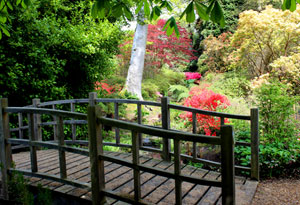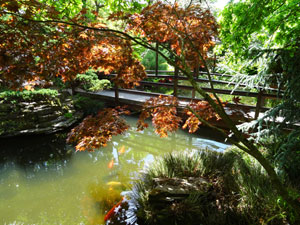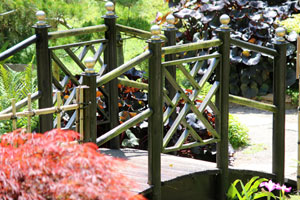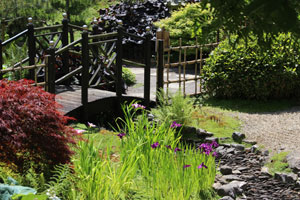Oriental Bridges
Japanese Garden Design

Whether it is spanning a gentle meandering stream or providing a way to cross a large koi pond, an oriental bridge can become a real focal point for any water feature.
Pedestrian bridges can be made from a variety of different materials, such as wooden zig-zag planks, bamboo, curved granite or stone.
Styles and Construction
Some bridges are rather understated and subtle, such as a simple row of irregular stepping stones, stone slabs or wooden planks stretching across a pond, raised above the surface of the water on hidden brick posts.

Others are designed with real flair and for maximum impact, with ornate trellis-like detailing in contrasting colours, such as bright red and black in a classical Chinese / Japanese style.
For the ultimate impact, a wooden 'Drum' or 'Moon' bridge (Taiko Bashi) is especially dramatic, with its steep semi-circle arch reflecting in the still water beneath to create a full round circle, as a symbolic representation of the moon itself.
Moon bridges actually originate from China and tend to be so steep that they often incorporate steps, being designed to make people slowly cross the water beneath and take the time to fully appreciate the elevated views of the garden from the top of the arch. Being so highly arched, some are placed over narrow rivers and canals, allowing barges and small boats to comfortably pass underneath.

Timber Protection
In Japanese garden design, bridges need to be both functional and attractive in their appearance. If using wood as your chosen material, then it is important that it is pre-treated (tanolised) to protect the timber against rotting, especially if the posts are standing directly in the water of the pond or stream beneath.
Worth noting, it is vital that you check if the wood preserver or paint could contaminate any pond water when it rains, potentially harming fish living beneath the bridge.

Garden History
Bridges in Japanese gardens date back to the Edo period of history (early 17th century to mid-19th century), when they were introduced to promenade gardens after streams and pathways became popular additions. These crossings allowed visitors to walk all around the garden, without any obstacles getting in the way, such as water.
Pebble River Beds
In a more modest back garden, you may not have room for a trickling stream as such. However, you can always suggest a stream by making a dry river bed, or imply the presence of water with neatly arranged rows of pebbles or slate paddlestones.
 Whether it is spanning a gentle meandering stream or providing a way to cross a large koi pond, an oriental bridge can become a real focal point for any water feature.
Whether it is spanning a gentle meandering stream or providing a way to cross a large koi pond, an oriental bridge can become a real focal point for any water feature. Others are designed with real flair and for maximum impact, with ornate trellis-like detailing in contrasting colours, such as bright red and black in a classical Chinese / Japanese style.
Others are designed with real flair and for maximum impact, with ornate trellis-like detailing in contrasting colours, such as bright red and black in a classical Chinese / Japanese style.
